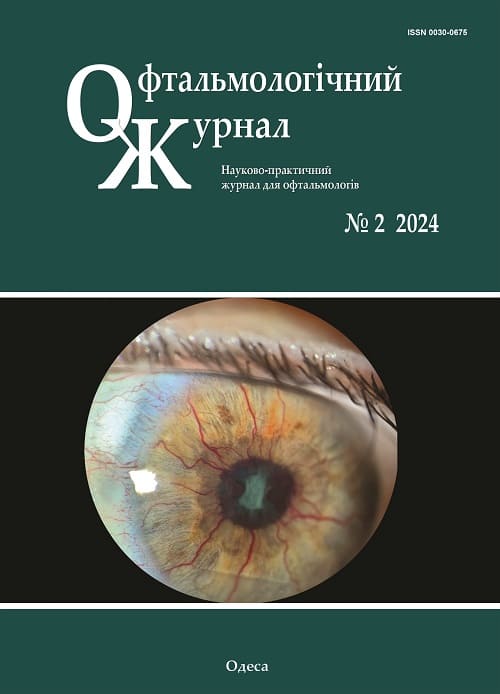Molecular mechanisms of immunomodulating effects of Aloe polysaccharide extract and Aloe Liquid Extract on lymphocyte activation markers СD5+ and СD54+ (ICAM-1) in vitro in patients with non-infectious uveitis and viral keratitis
DOI:
https://doi.org/10.31288/oftalmolzh2024238Keywords:
aloe polysaccharides, markers of lymphocyte activation CD54 (ICAM-1), CD 5 , immunomodulating effect in vitro, non-infectious uveitis, viral keratitisAbstract
Background: Because Aloe polysaccharides, to some degree, determine the high biological activity of the plant, the development of an ophthalmic dosage form based on these compounds is an important and promising field of pharmacology.
Material and Methods: We determined relative and absolute expression of the intercellular adhesion marker CD54+ and autoagression marker CD5+ in the peripheral blood lymphocytes of patients with acute non-infectious uveitis and those with acute viral keratitis before and after incubation with Aloe polysaccharide extract and Aloe Liquid Extract. Patients were divided into two groups: group 1 (10 patients with non-infectious uveitis) and group 2 (17 patients with viral keratitis). Mean patient age plus or minus standard deviation was 49.87 ± 3.89 years. Control group was composed of 20 healthy donors of a similar age.
Purpose: to investigate in vitro the levels of expression of CD 5+ (a molecular marker of autoimmune activation) and CD 54+ (a molecular marker of intercellular adhesion), in peripheral blood lymphocytes of patients with non-infectious uveitis and viral keratitis before and after incubation with Aloe polysaccharide extract and Aloe Liquid Extract.
Results: In both groups of patients, relative and absolute expressions of CD 5+ and CD 54+ in the peripheral blood lymphocytes were significantly increased compared to healthy controls. After incubation with Aloe polysaccharide extract and Aloe Liquid Extract, the relative expression of CD5 in the peripheral blood lymphocytes in group 1 decreased 1.6 times and 1.9 times (to 15.4 ± 1.7% and 13.4 ± 2.1%), respectively. After incubation with Aloe polysaccharide extract, the expression of СD54+ in the peripheral blood lymphocytes in both groups of patients decreased 1.4 times, and this decrease was statistically significant. After incubation with Aloe Liquid Extract, the expression of СD54+ in both groups decreased 1.5 times, and this decrease was statistically significant, too.
Conclusion: Aloe polysaccharide extract and Aloe Liquid Extract have significant immunomodulating effect, which was indicated by the normalization of relative expression of intercellular adhesion and autoaggression markers in peripheral blood lymphocytes of patients with non-infectious uveitis and viral keratitis.
References
Ariaiev ML, editor. [Official national list of medications]. Kyiv; 2018. Ukrainian.
[The Ukrainian medication register]. Ukrainian. Available at: http://www.drlz.com.ua /ibp/ddsite.nsf/all/shlist?opendocument.
Wisher D. Martindale. The Complete Drug Reference. In: 37th ed. J Med Libr Assoc. 2012 Jan; 100(1):75-6. https://doi.org/10.3163/1536-5050.100.1.018
International aloe science council. Available at: https://www.IASC.COM.
Mulay S, Ogale S. Quality Control Study in Various Nutraceutical Aloe vera Formulations. Acta Scientific Pharmaceutical Sciences. 2018. 2; 8:3-9.
Kurizaki A, Watanabe T, Devkota HP. Chemical Constituents from the Flowers of Aloe arborescens. Nat Prod Commun. 2019;14 https://doi.org/10.1177/1934578X19844135
Olennikov DN, Ibragimov TA, Chelombit′ko VA, et al. Chemical composition of Aloe arborescens and its change by biostimulation. Chem Nat Comp. 2009;45:478-82. https://doi.org/10.1007/s10600-009-9405-z
Hirata T, Suga T. Biologically active constituents of leaves and roots of Aloe arborescens var. Natalensis. Z Naturforsch C Biosci. 1977 Sep-Oct;32(9-10):731-4.PMID: 145111. https://doi.org/10.1515/znc-1977-9-1010
Sierra-García GD, Castro-RR, González-HA, Lara-AJ, Chávez-MA. Acemannan, an Extracted Polysaccharide from Aloe vera: A Literature Review. Nat Prod Commun. 2014 Aug; 9(8): 1217-21. https://doi.org/10.1177/1934578X1400900836
Mukherjee PK, Nema NK, Maity N, Mukherjee K, Harwansh RK. Phytochemical and Therapeutic Profile of Aloe vera. J Nat Remedies. 14(1):1-26. doi:10.18311/jnr/2014/84.
Liu C, Cui Y, Pi F, Cheng Y, Guo Y, Qian H. Extraction, Purification, Structural Characteristics, Biological Activities and Pharmacological Applications of Acemannan, a Polysaccharide from Aloe vera: A Review. Molecules. 2019 Apr 19;24(8):1554. https://doi.org/10.3390/molecules24081554
Hęś M, Dziedzic K, Górecka D, Jędrusek-Golińska A, Gujska E. Aloe vera (L.) Webb.: Natural Sources of Antioxidants - A Review. Plant Foods Hum Nutr. 2019 Jun 18;74(3):255-65. https://doi.org/10.1007/s11130-019-00747-5
Bhalang K, Thunyakitpisal P, Rungsirisatean N. Acemannan, a Polysaccharide Extracted from Aloe vera, Is Effective in the Treatment of Oral Aphthous Ulceration. J Altern Complement Med. 2013 May;19(5):429-34. https://doi.org/10.1089/acm.2012.0164
Pellizzoni M, Růžičková G, Libor Kalhotka, Lucini L. Antimicrobial activity of different Aloe barbadensis Mill. and Aloe arborescens Mill. leaf fractions. J Med Plants Res. 2012 Mar 16;6(10):1975-81.
Ataunekh KhE, Pugachova KS. [Biogenic stimulators and use of Folia Aloe arborescens in pharmacy]. In: [Proceedings of the conference on Current trends in medical and pharmaceutical sciences]. Dec 2-3, 2016; Kyiv. Kyi: Kyiv Medical Science Center; 2016. p. 99-101. Ukrainian.
[Instruction on the Medical Application of the "Aloe extract" Medication]. Available at: https://helsi.me/liki/kyiv/aloe-extract/29409/instruction
Decree No. 364 of the Ministry of Health of Ukraine "On the approval of protocols for sanatorium-and-spa treatment of children in sanatorium-and-spa facilities of Ukraine" dated May 28, 2009.
Velychko LM, Zborovska OV, Kuryltsiv NB, Bogdanova OV. Expression of lymphocyte activation markers CD 54 (ICAM-1), CD 5, CD 95 (FAS) and neutrophil activation marker CD15 in the peripheral blood of patients with intermediate uveitis and healthy individuals. J Ophthalmol (Ukraine). 2021;6:16-20. https://doi.org/10.31288/oftalmolzh202161620
Velichko L. [The level of activated lymphocytes molecular markers expression in peripheral blood in patients with uveal melanoma in varying efficiency preserving therapy]. J Ophthalmol (Ukraine). 2013 Oct 14;45(5):9-13. Ukrainian. https://doi.org/10.31288/oftalmolzh20135913
Khramenko NI, Gaidamaka TB, Drozhzhyna GI, Velychko LN, Bogdanova AV. ICAM-1 expression on blood lymphocytes in patients with stromal herpes keratitis at different periods of disease. J Ophthalmol (Ukraine).2020;3:23-8. https://doi.org/10.31288/oftalmolzh202032328
Khramenko N, Velychko L, Konovalova N, Bogdanova O, Dumbrăveanu LG, Bobescu DV. Features of hemodynamic and immunological parameters in patients with recurrent uveitis complicated by hypertension, Fuchs heterochromic uveitis and Posner-Schlossman syndrome. Romanian Journal of Ophtalmology. 2023 Jan-Mar 12;67(1): 20-32. https://doi.org/10.22336/rjo.2023.5
Degtiarenko TV, Makulkin RF. [Biogenic stimulators and immunoreactivity]. Odesa: Maiak; 1987. Russian.
Sotnikova OP, Abramova GB, Sokolova BN, Lotosh TD, Sherina NM, inventors; SI "The Filatov Institute of Eye Diseases and Tissue Therapy", the Patent Holder. Patent of Ukraine No. 7042. [A method for producing a concentrated extract of aloe]. Published June 15, 2005. Ukrainian.
Gluzman DF, Skliarenko LM, Nagorna VA, Kriachok IA. [Diagnostic immunocytochemistry of tumors]. Kyiv: Morion; 2003. Ukrainian.
Velychko LM, Bogdanova OV, inventors; SI "The Filatov Institute of Eye Diseases and Tissue Therapy", the Patent Holder. Patent of Ukraine No. 103,483. [A method for studying the receptor-modifying effect of pharmacological immunotropic drugs (Amiksyn IC) on markers of cell activation]. Published December 25, 2015. Bul. No. 24. Ukrainian. Available at: https://base.uipv.org/searchINV/search.php?action=viewdetails&IdClaim=218795
Bai Y, Niu Y, Qin S, Guowu Ma. A New Biomaterial Derived from Aloe vera-Acemannan from Basic Studies to Clinical Application. Pharmaceutics. 2023 Jul 9;15(7):1913. https://doi.org/10.3390/pharmaceutics15071913
Li L, Xu W, Luo Y, Lao C, Tong X, Du J, et al. Aloe polymeric acemannan inhibits the cytokine storm in mouse pneumonia models by modulating macrophage metabolism. Carbohydr Polym. 2022 Dec 1:297:120032. https://doi.org/10.1016/j.carbpol.2022.120032
Konovalova NV. [Application of aloe extract and pelovit in treatment of chiroretinitis of tuberculous etiology]. Oftalmol Zh. 2011;2:23-6. Russian. https://doi.org/10.31288/oftalmolzh201122326
Ahluwalia B, Magnusson MK, Larsson F, Savolainen O, Ross AB, Öhman L. Differences in Metabolite Composition of Aloe barbadensis Mill. Extracts Lead to Differential Effects on Human Blood T Cell Activity In Vitro. Molecules. 2022 Oct 6;27(19):6643. https://doi.org/10.3390/molecules27196643
Downloads
Published
How to Cite
Issue
Section
License
Copyright (c) 2024 Галина Фесюнова, Кисіль

This work is licensed under a Creative Commons Attribution 4.0 International License.
This work is licensed under a Creative Commons Attribution 4.0 International (CC BY 4.0) that allows users to read, download, copy, distribute, print, search, or link to the full texts of the articles, or use them for any other lawful purpose, without asking prior permission from the publisher or the author as long as they cite the source.
COPYRIGHT NOTICE
Authors who publish in this journal agree to the following terms:
- Authors hold copyright immediately after publication of their works and retain publishing rights without any restrictions.
- The copyright commencement date complies the publication date of the issue, where the article is included in.
DEPOSIT POLICY
- Authors are permitted and encouraged to post their work online (e.g., in institutional repositories or on their website) during the editorial process, as it can lead to productive exchanges, as well as earlier and greater citation of published work.
- Authors are able to enter into separate, additional contractual arrangements for the non-exclusive distribution of the journal's published version of the work with an acknowledgement of its initial publication in this journal.
- Post-print (post-refereeing manuscript version) and publisher's PDF-version self-archiving is allowed.
- Archiving the pre-print (pre-refereeing manuscript version) not allowed.












